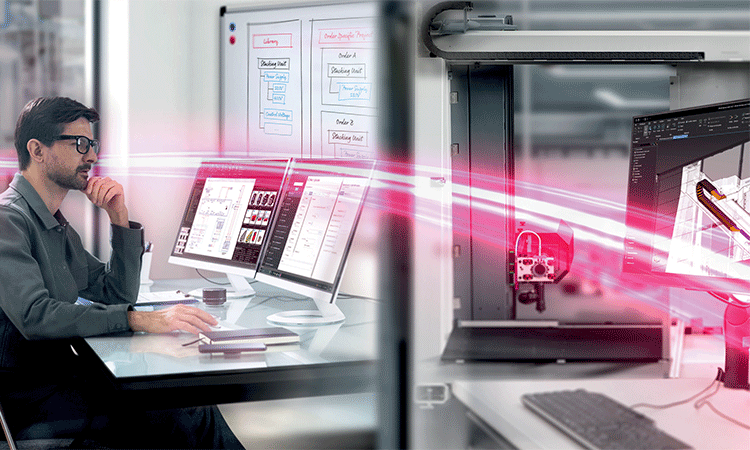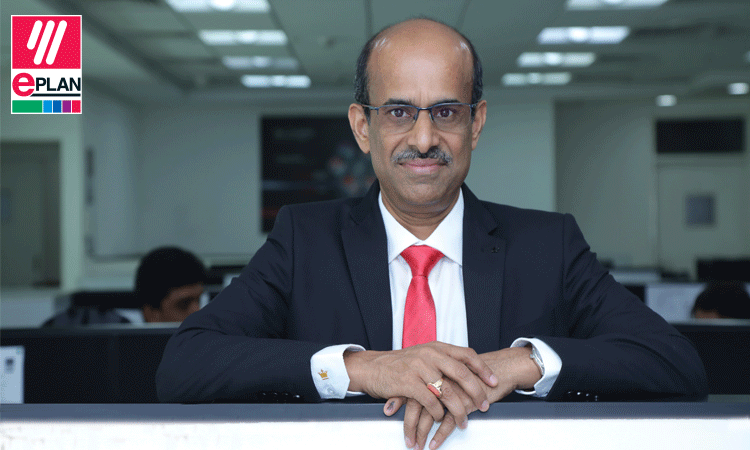Powering the Future of Engineering with Intelligence & Integration
In an era defined by digital acceleration and cross-disciplinary collaboration, Eplan emerges as a transformative force in the world of engineering. With its unified platform and cutting-edge cloud ecosystem, the company is redefining what “efficient engineering” truly means. From automotive and energy to food & beverage, Eplan empowers industries to work smarter, automate faster, and design with unprecedented precision. At the helm of this transformation is Umesh Pai, Managing Director of Eplan Software Pvt. Limited, who shares how the brand’s legacy, innovation, and customer-centric approach are shaping the future of engineering. Excerpts from an interview
Q1. Eplan’s tagline is “Efficient engineering.” How does your software solutions help customers achieve this in practical terms?
At Eplan, “Efficient engineering” is more than a tagline—it’s a guiding principle that shapes our technology and services. Our integrated platform streamlines workflows across electrical, fluid, and automation disciplines, allowing engineering teams to work more quickly and with fewer errors. For example, through automation tools and intelligent templates, engineers can reuse proven designs instead of starting from scratch, significantly cutting project timelines.
Our cloud-based ecosystem—including eMANAGE, eSTOCK, and eVIEW—ensures real-time collaboration, enabling distributed teams to access, edit, and share project data securely and simultaneously. This eliminates data silos, increases transparency, and enhances project control.
Moreover, our subscription-based licensing keeps customers on the latest software version with predictable costs, while our consulting services help adapt Eplan to each client’s specific processes. The result is not just faster engineering—it’s smarter, future-ready design that delivers long-term value.
Q2. Eplan serves a wide spectrum of industries. How do you tailor your solutions to meet the unique challenges of sectors like automotive, energy, and food & beverages?
Eplan takes an industry-specific approach to engineering. In automotive, where flexibility and speed are critical, our tools support everything from configuration management to modular system configuration. Templates, digital twins, and automated documentation help OEMs and suppliers streamline production and ensure standardization across model variants.
In the energy sector, we address challenges like grid modernization and renewable integration. Our platform supports cross-disciplinary workflows for substation design, panel building, and control system engineering, while cloud-based collaboration ensures alignment between planners, contractors, and utilities.
For food and beverage, the focus is on hygiene, speed, and compliance. Eplan’s solutions help design automated packaging and processing systems with clear, validated documentation. We support compliance with sector-specific regulations and enable quick reconfiguration in dynamic production environments. Our ability to deliver tailored, modular tools for each sector allows customers to respond to market demands with agility and precision.
Q3. Data consistency and integration are emphasized in your offerings. Can you elaborate on how Eplan’s interfaces to ERP and PLM/PDM systems enhance engineering workflows?
Data consistency is fundamental to modern engineering efficiency. Eplan enables bi-directional integration with ERP, PLM, and PDM systems so that design changes are instantly reflected across the value chain—from procurement to production. This eliminates the need for duplicate data entry and minimizes the risk of human error.
For instance, a change in a component in the schematic automatically updates the bill of materials and is communicated to procurement teams via the ERP. This ensures cost and inventory data remain accurate and synchronized with real-time project requirements.
Additionally, our integrations support process traceability and compliance by linking engineering data with document control, part libraries, and lifecycle management. Combined with cloud-based tools, this creates a unified digital thread—one that connects engineering design with operational execution, enabling organizations to make better decisions faster.
Q4. With over 68,000 customers globally, how does Eplan ensure customer success and maintain long-term partnerships across such a vast client base?
We see our customers as long-term partners. Eplan invests heavily in global customer support through the Eplan Solution Center, offering multilingual, around-the-clock assistance. We also offer a broad range of training programs—online, in-person, and hybrid—to ensure users are confident and productive from the start.
Our consulting services go deeper, helping companies restructure workflows, migrate legacy data, and optimize their engineering processes. Importantly, we use feedback loops with our customer base to refine and evolve our product roadmap.
Eplan also stays engaged post-implementation, regularly introducing updates, new features, and productivity-enhancing tools. By combining technical support, personalized consulting, and a flexible subscription model, we ensure our customers are equipped to adapt, grow, and innovate well beyond their initial deployment.
Q5. Could you highlight some key differentiators that set Eplan apart from other design software providers in the market?
Eplan’s strength lies in its role as a unified engineering ecosystem—not just a standalone tool. Our integrated platform spans electrical, automation, and fluid engineering, ensuring seamless project execution across disciplines. Few competitors offer this depth of cross-domain integration.
We also offer specialized applications tailored to specific industries, supported by a strong library of standardized components and templates that accelerate design and improve quality.
Our emphasis on digital integration—with full connectivity to ERP, PLM, and PDM systems—fosters enterprise-wide synchronization. In addition, cloud-based tools like eMANAGE and eSTOCK allow global collaboration and data transparency.
What truly sets Eplan apart is our commitment to customer enablement—through expert consulting, subscription flexibility, and a roadmap driven by real-world engineering needs. These differentiators position Eplan not just as a vendor, but as a strategic partner for digital transformation.
Q6. How is Eplan supporting customers in adopting automation and digital transformation in their engineering processes?
Eplan empowers customers to move toward digital transformation with both technology and expertise. Our software automates time-consuming tasks like wiring diagrams and documentation, freeing engineers to focus on system design and innovation.
The Eplan Engineering Standard provides templates and best practices that accelerate the shift to standardized, digital workflows. Cloud platforms allow data to be stored, accessed, and edited securely by stakeholders across departments and geographies.
Beyond the software, our consultants help customers identify automation opportunities, implement smart tools, and transition from paper-based to digital processes. We focus on both quick wins and long-term value—helping companies not only adopt new technologies but use them strategically to enhance competitiveness.

Q7. Can you tell us more about the consulting and training services you offer and how they contribute to the overall value proposition?
Our consulting and training services are central to our promise of efficient engineering. We know software success depends on people and processes, so we offer comprehensive onboarding, modular training courses, and role-specific certifications to ensure knowledge retention.
Our consultants work closely with customers to analyze current processes, design future-ready workflows, and ensure smooth integration with existing IT systems. We also provide hands-on help for setting up part databases, defining automation rules, and migrating legacy projects.
In sectors like energy and utilities, we deliver advanced virtual training environments using digital twins and AR simulations—enhancing safety and preparation for real-world operations. These services help organizations maximize their investment in Eplan, shorten ROI timelines, and build internal expertise.
Q8. With roots going back to 1984 and being part of the FriedhelmLoh Group, how does Eplan combine heritage with innovation to stay ahead in a competitive market?
Eplan’s heritage gives us a deep foundation in engineering excellence, while our position within the FriedhelmLoh Group ensures stability, vision, and investment for future growth. This duality allows us to deliver tried-and-tested reliability while continually pushing boundaries. We invest in R&D to bring emerging technologies like cloud services, AI-assisted design, and digital twins into practical application. Our involvement in industry alliances and standards bodies ensures our solutions stay aligned with global trends and compliance requirements.
By honoring our legacy and driving innovation, Eplan remains both a trusted and progressive partner—ready to meet today’s needs and anticipate tomorrow’s.
Q9. Looking ahead, what are some strategic initiatives or technological advancements Eplan is focusing on to shape the future of engineering?
Eplan is committed to shaping the future through intelligent cloud engineering, increased automation, and deeper enterprise integration. We’re expanding support for decentralized energy systems, e-mobility infrastructure, and smart grid technology—particularly relevant to our customers in the energy sector.
We’re also enhancing our cybersecurity measures and aligning our platforms with international compliance and sustainability standards. Looking forward, we’re focused on enriching our digital twin capabilities, exploring AI-driven design automation, and enabling seamless collaboration across the engineering value chain.
These strategic investments reflect our belief that the future of engineering lies in connected, intelligent, and agile platforms—where innovation, precision, and speed go hand-in-hand.




